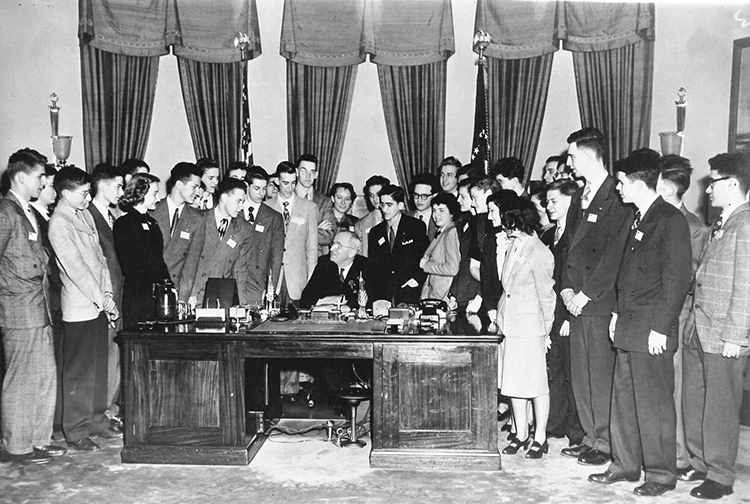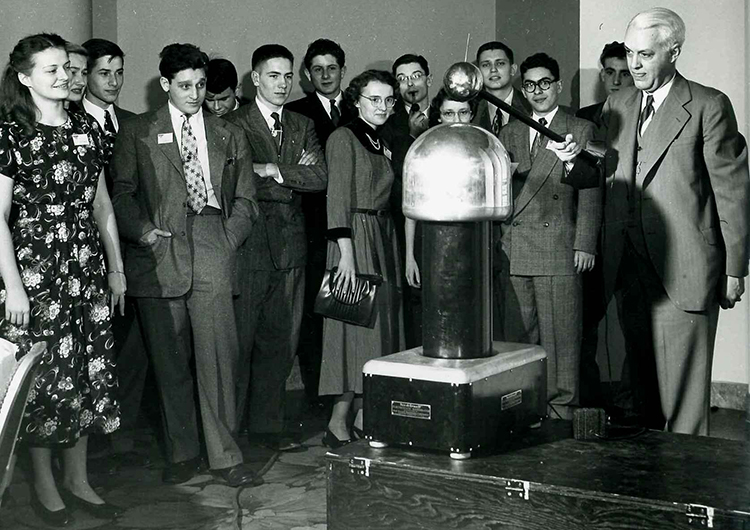Alumni, Science Talent Search, Westinghouse STS
Science: It’s all in the family
Science is a family affair for the Dells. George (Fritz) Dell was a Science Talent Search finalist in 1949, and his daughter Kristi (Dell) Snell was a finalist in 1985. Kristi and her brother grew up watching their dad George conduct physics research at the Brookhaven National Laboratory, where their mother also worked. Kristi also interned in the lab’s biology department while she was in high school.
Dell and Snell discussed their family’s shared passion for science with the Society.
Was science and research always a big part of your family?
G. Dell: As a physicist at Brookhaven National Laboratory, my daughter and son often went to my office and lab and watched me conduct research on my physics projects. They both spent many hours at the laboratory campus, touring and participating in lab events. My daughter worked as a summer intern in the biology department while in high school and eventually became a biochemist. My son is an electrical engineer.
K. Snell: My father had many hobbies related to science and our basement was filled with items such as an oscilloscope, soldering irons, electrical components, circuit boards, various fossils, and a large mineral collection. While my brother displayed more interest in these items at an earlier age than I did, I do think growing up in this environment helped to develop my interest in science. Both of my parents worked at Brookhaven National Laboratory on Long Island, which provided its own influence. My father was a high energy physicist and my mother worked in personnel. My brother and I were often on the lab grounds during the summer, participating in lab programs, swimming, playing tennis, and occasionally accompanying my father to load his computer punch cards or pick up computer printouts. My father’s dedication to his work was very evident as he often looked over his computer printouts in the evening while we did our homework. I did my first lab work in the biology department at Brookhaven Lab during a high school summer internship.
What was it like for both of you to compete in STS?
G. Dell: The STS competition in 1949 was the highlight of my high school career, and I received public recognition in the local newspapers and at my small country school. I was very proud to have my daughter enter the STS contest in 1985 and actually be in the top 40.
K. Snell: My father’s prior participation in STS was how I found out about the competition and he encouraged me to enter. At the time, my high school did not have a program that encouraged students to enter science fairs and they were just starting a program to promote independent projects in science. I enrolled in the independent study program and the Westinghouse STS was my first science fair. After I was selected as part of the STS top 40 group, my father was able to tell me what kind of activities and sessions he participated in during his trip to Washington, which gave me an idea of what to expect.
What were your most memorable moments as a 1949 (Dell) and 1985 (Snell) STS finalist?
G. Dell: My most memorable moments were viewing the projects other high school students had created and exhibited. I was impressed with the talent and creativity of the other top 40 participants. My favorite moment was attending the awards dinner and hearing the names of the top 10 winners.
K. Snell: My most memorable moment was the formal award dinner in Washington at the end of the STS event. The dinner’s attendees were really interested in the STS students, their work, and their future career plans. It was a very special experience. I also enjoyed visiting the office of New York’s Senator Daniel Moynihan with the other New York students during our time in Washington, D.C.

Can you provide a short description of your research project and how you initially became interested in this topic?
G. Dell: My project involved a unique form of residential lighting from a Tesla coil — an electrical transformer circuit invented by Nikola Tesla around 1891. After reading about Tesla coils in my science classes, I worked on a project to submit to the STS contest.
K. Snell: My family travelled to Indiana and Ohio two to three times a year to visit relatives. For as long as I can remember, we often walked through farm fields that were recently plowed to look for Indian artifacts. My STS project focused on Indian artifacts that I found in a field on a farm in Indiana where my grandmother grew up. I classified arrow heads and other stone tools found in this field based on their shape and style of workmanship. Since distinct styles and quality of workmanship are associated with different archaeological time periods, I was able to compare this information to several literature sources to estimate the time period in which the artifacts were made. This data helped me to determine the time periods during which this field was likely an Indian site.
(For George): The winners of your Science Talent Search met with President Harry Truman on March 3, 1949. What was it like to meet the president?
G. Dell: Visiting the White House and meeting Harry Truman was certainly a highlight of the trip for a young boy from Ohio. This was my first trip to Washington, D.C. and the White House.

Were your experiences with STS influential in your career paths?
G. Dell: Yes, my participation in STS certainly encouraged me to go on to college and study science. I chose physics and wanted to work on a PhD to follow in the footsteps of a favorite uncle who had a PhD in chemistry.
K. Snell: I was astonished at the breadth, diversity, and creativity of the projects that were displayed at the STS event where the finalists showcased their research. This impressed on me that even young high school students can perform rigorous research and make real discoveries. It was an honor to be part of this group of students and certainly provided added incentive and confidence to explore a career in science.

(For Kristi): What STEM-related projects are you working on now in your role at Metabolix?
K. Snell: My science career has focused on the metabolic engineering of bacteria and plants to produce value-added products. Through metabolic engineering, one can genetically alter an organism to redirect a portion of its metabolism to produce a target product, such as a molecule or polymer, or to enhance its growth and yield. I first started work with bacteria while obtaining a PhD in Organic Chemistry from Purdue University and continued in this field as a postdoctoral associate at MIT in the Department of Biology. At MIT, I worked on a project related to the production of a class of biodegradable renewable polymers, called PHAs, in bacteria. In 1997, I joined a small biotechnology company, Metabolix Inc., that had previously spun out of MIT to commercialize this class of polymers. During my first 15 years at Metabolix, my work focused on the production of PHA biopolymers in plants, including switchgrass, Camelina, and tobacco. In my more recent role as Vice President of Research and Biotechnology, I oversee the company’s research to produce commercial bacterial production strains for our PHA polymers as well as plant science research to create PHA producing plants or plants with enhanced yield.
I am very excited about a new project that I am participating in to spin out Metabolix’s plant science research into a new company called Yield10 Bioscience. The plant science team has developed some proprietary breakthrough technologies, based on novel genetic traits and targeted metabolic engineering, which can be used to improve yield in major food, feed, and energy crops. Improved crop productivity will become increasingly important as we try to feed, clothe, and fuel a growing world population which the United Nations has estimated will increase from 7 billion to 9 billion by 2050. To support this growth, new novel agricultural solutions will be required to enhance crop yield. Yield10 will focus on developing these solutions.
Do you have any career highlights that you would like to share?
G. Dell: I worked and visited many national labs during my career in nuclear physics and particle physics. I even had the opportunity to work for several years on a particle physics accelerator at CERN, a physics laboratory in Geneva, Switzerland. My last project was working on RHIC (the Relativistic Heavy Ion Collider) at Brookhaven National Laboratory, before my retirement in 1994. RHIC is still being used for research in 2015.
K. Snell: I have been very fortunate to be a part of some great teams at Metabolix, teams that have really pushed the envelope in the field of metabolic engineering. Our teams have succeeded in rewiring carbon flow in plants to produce the highest levels of polymer ever reported in tobacco, switchgrass, and oilseeds. In some of our more recent work, we are applying our metabolic engineering expertise to increase crop productivity and yield and have obtained some exciting results that will form the basis of our new crop spin-out Yield10.

What is your advice to young students interested in science and math?
G. Dell: I would certainly encourage high school students to study science and math and pursue an exciting career with good job opportunities. Young women need to be encouraged to study science since we need to have more women in the field of science and engineering.
K. Snell: I think it is important to have a role model in science that helps you to visualize yourself embarking on a similar career path. This is especially important for women and minorities that may be underrepresented in certain STEM fields. There were several women in science, both during my formative high school years and later in life when I had chosen my field, that provided me with a positive example of a career path for women in science.


